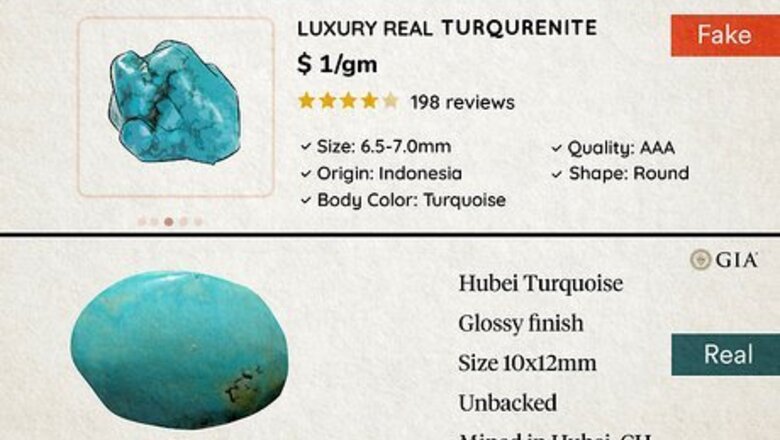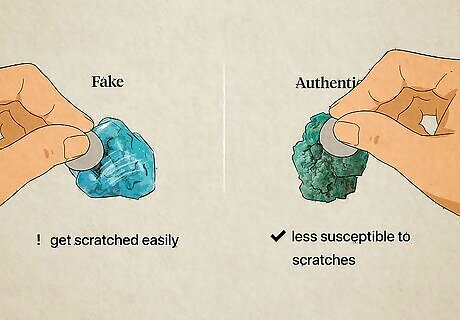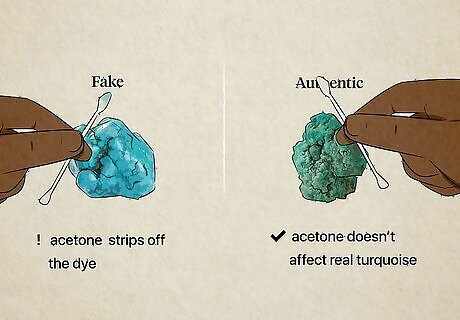
views
- Real turquoise is rare, so it comes with an expensive price tag. Fakes are made with dyed howlite, magnesite, or plastic that is cheap to produce.
- Authentic turquoise is an opaque robin’s egg blue or greenish blue. If it’s transparent or white, red, or purple, it’s probably fake.
- Real turquoise doesn’t scratch easily. If you can chip at your piece with your fingernail or a coin, it’s likely a fake.
Price

Real turquoise is about $1-10 per carat, so be wary of cheap prices. If it seems like the price of the turquoise jewelry or gem you’re looking at is too good to be true, it probably is. Turquoise is a rare stone that typically costs between $1-10 per carat (1 carat is equal to 200 milligrams). Imitation turquoise is usually made from minerals like howlite, magnesite, and glass, as well as plastic and resin, which are dyed blue. These minerals and materials are much cheaper to produce. For example, a real beaded turquoise necklace might cost upwards of $700, while a fake is often as cheap as $20. Look for turquoise from reputable jewelers with Gemological Institute of America (GIA) certifications, or from GIA-certified gemologists. Ask retailers where the turquoise comes from. Most of it is mined in the United States, Mexico, Iran, Chile, Egypt, and China. A reputable seller will know exactly where the turquoise came from, while imitators won’t. Fake turquoise is often sold under names like Buffalo Turquoise, Viennese Turquoise, Utah Turquoise, and Turqurenite.
Color

Authentic turquoise ranges from robin’s egg blue to greenish blue. Turquoise only comes in these colors, so if you see white, red, purple, yellow, or bright green turquoise, it’s fake. The real deal is an opaque stone where the color isn’t always perfectly distributed, so there might be some lighter or darker spots. It’s not transparent or translucent, which is another sign of a fake. Fake turquoise might also have white spots, which you don’t see in real turquoise. These white spots are usually places where the dye didn’t fully absorb. If you have a rough-cut turquoise, look at the cracks and grooves on the gem. The dye used on fakes often builds up in these areas, which is unnatural in real turquoise. Turquoise is formed from copper and aluminum, which is where it gets its rich color.
Pattern

Real turquoise has a unique webbing matrix that fakes can’t imitate. Turquoise forms inside limonite and sandstone, so it often contains thin lines or thick splotches of brown rock throughout, which is called a spider web matrix. While howlite also has a webbed pattern, its lines are longer, more rounded, and more flowy than a true turquoise’s sharp edges. Howlite’s webbing is also light gray, which you don’t typically see in real turquoise. Fake turquoise made out of plastic or resin might have webbing that’s painted on. Inspect the lines closely to see if there are obvious paint strokes. Not all turquoise has a webbing matrix and many jewelers cut it out. If your turquoise is completely solid, use another method to check its authenticity.
Weight

Authentic turquoise is heavier than plastic or resin fakes. If you suspect that you have inauthentic turquoise, hold it in one hand and a similarly sized piece of plastic or resin in the other. If the gem feels about the same weight as the plastic, it’s probably fake. Plastic has a specific gravity of around 0.9 while turquoise has a specific gravity of 2.5-2.9, so turquoise usually feels twice as heavy as fakes. Fake turquoise made from howlite, magnesite, or glass is a similar weight to real turquoise, so use another test to determine if you have an authentic piece.
Fingernail Test

Real turquoise’s spider web matrix catches on your fingernail. Lightly run your fingernail over your turquoise piece if it has a spider web matrix. If your fingernail catches on the lines or splotches of brown, that’s a good sign it’s authentic. Because plastic and resin fakes often paint on the webbing, your nail won’t catch on the brown veins if it’s fake.
Scratch Test

Authentic turquoise is less susceptible to scratches than imitations. Use your fingernail, a coin, or a butter knife to scrape a small, hidden section of the turquoise. If the turquoise piece scratches easily, it’s likely inauthentic. While turquoise is a softer gem with a Mohs hardness of 5 to 6, howlite and magnesite are even softer with a rating of 2. So, real turquoise won’t chip or scratch from your nail or a coin.
Acetone Test

Acetone doesn’t affect real turquoise, but strips off the dye from fakes. Wet a cotton swab with acetone or nail polish remover and rub it into an inconspicuous part of the turquoise. If the gem is white where you rubbed in the acetone or there are blue streaks on the swab, you have a fake on your hands. It is likely howlite, magnesite, or plastic dyed a turquoise blue.
Melt Test

Authentic turquoise doesn’t melt easily while plastic fakes do. Hold a metal sewing needle under a lighter flame to heat it up. Then, press the needle into a concealed section of the turquoise. If it’s made out of plastic or resin, the needle will melt the turquoise and you’ll smell burning plastic. On the other hand, the needle won’t do anything to genuine turquoise.
Destructive Test

Real turquoise is the same color all the way through the center. One easy way to tell if turquoise is real is to break it apart, so only do this if you don’t mind having tiny pieces of turquoise. Just take a hammer and hit the center of your stone. The dye that fakes use usually only penetrates the outside of the stone, so the inside is white. Real turquoise is the same color on the inside and out.




















Comments
0 comment